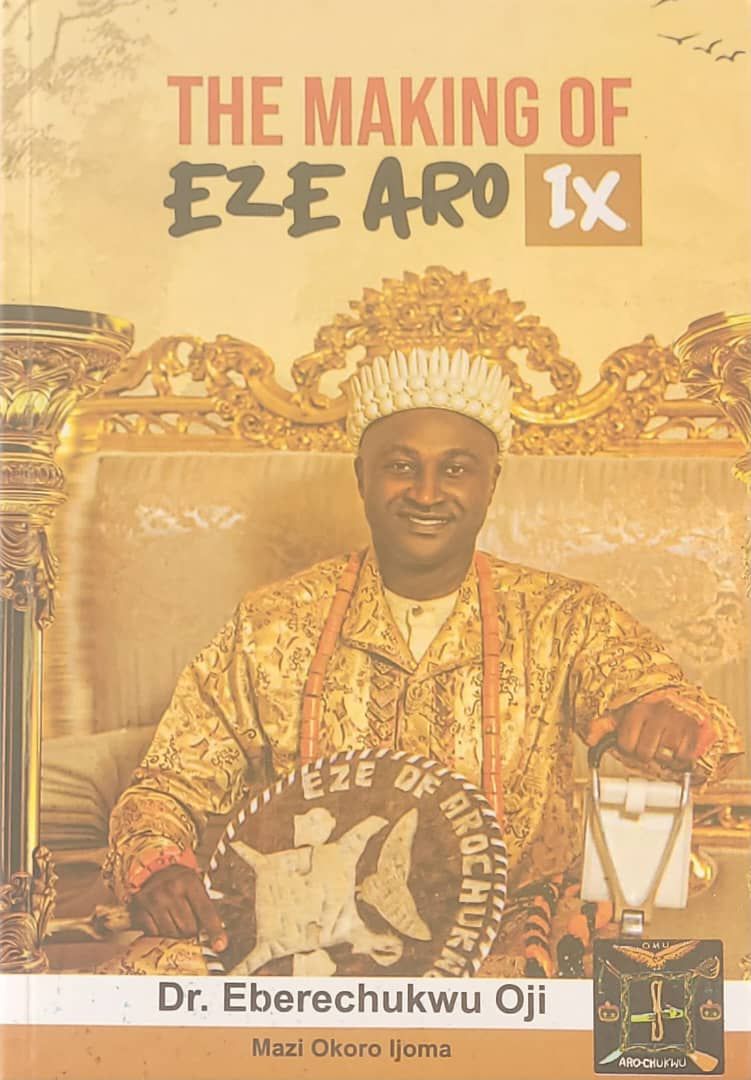BOOK REVIEW
Title: The Making of Eze Aro IX
Dr. Eberechukwu Oji
Author Prof. (Mazi) Okoro Ijoma
Publishers: University of Nigeria, Nsukka Press Ltd
Reviewer: Ogechukwu Aguzie
I found the task of reviewing a book written by an erudite scholar, renowned Professor of history and Fellow, Historical Society of Nigeria, Professor Okoro Ijoma, very daunting and intimidating. This very cerebral and globally acclaimed historian is a man I cannot afford to feed on his intellectual table. But I had to brave the task with the hope that I would not be found guilty of community intellectual harakiri.
The book, the making of Eze Aro IX, according to the author, is the second in the series of such publications aimed at providing historical background and unfettered information regarding the process of selecting and enthroning Eze Aro, in line with the age-long Aro customs and tradition.
The first edition of the book (The making of Eze Aro VIII) was published to mark the coronation of Mazi Vincent Ogbonnaya Okoro, CFR as Eze Aro. He ruled the ancient Arochukwu kingdom for 25 years (1995-2020) before transiting to join his ancestors. Divided into Six chapters, the tiny book of 147 pages contains very interesting and fascinating stories about Arochukwu, its people, history, culture and civilization.
As the saying, the making of a great book is not in the volume but the content. Mazi Ijoma, as an accomplished historian, provided very refreshing perspective on the history and selection process of Eze Aro.
The first chapter of the book, Arochukwu and its people, contains brief historical background of Arochukwu and its location. According to the author, though colonial officers who investigated the issues of Aro origin tended to derive Aro origin from outside Igbo land, because of the high level of socio-economic organization they had attained prior to the colonial administration, the stories as told by the people indicate that their founding fathers were Igbo and some accretion from the Cross River.
Arochukwu, from the established historical evidence, which was also highlighted by the author, is made up of three patrilineages namely, Oke Nnachi, Ibom Isii and Eze Agwu Na Okwara Agwu. The town is made up of 19 villages, which are spread over the three patrilineages.
Headship in Aro, according to the author, is hereditary, but not necessarily primogenitary. The highest level of authority in Aro is the “Okpa-Nkpo”, which can also be referred to as the Eze Aro’s cabinet. The author asserted that, “it appears Okpa-Nkpo was mainly composed of the heads of Otusi (three originally but rose to nine in number)”.

However, with the passage of time, all heads of the 19 villages were made members. The number has also been increased to include some prominent members of the community and Nzuko Aro. The Okpa-Nkpo, whose chairman is the Eze Aro, meets or should meet once – every 8th day or Avo Ukwu at Oror village (the administrative and traditional headquarters of the community), to deliberate on matters affecting the community.
It is also vested with the responsibility of resolving disputes arising from the village and kindred councils.
Perhaps, one of the most interesting part of Aro history, which was highlighted by the author, was the importance and influence of their highly revered deity Ibiniukpabi, which the colonial masters described as “Long juju”.
According to him, contrary to the erroneous impression by the British that Ibiniukpa was used for the recruitment of slaves and the manipulation of religious fears of other Nigerian peoples, the geographical position of Arochukwu made it impossible for the oracle to serve as a conduit for any large percentage of slaves sold at the coast.
He however, acknowledged that the influence of the oracle aided the Aro trading networks spread over south eastern Nigeria and beyond. Apart from helping the commercial interest of the Aros, the oracle played key role in resolving disputes in distant communities and those who came from far and near in search of solution to their problems.
Prof. Ijoma, who no doubt has written extensively on Aro history, highlighted the numerous contributions and achievements in the development of their homeland and other communities where they found themselves. For instance, the Aro, who were noted as long distant merchants and adventurers had settled and made home in various parts of south eastern Nigeria, where they contributed to the social, economic, and cultural life of the people.
However, this seeming dominance of the Aro in the trading activities in the south eastern Nigeria, brought them into direct confrontation with the British colonial authorities who saw them as an obstacle to gaining access into Igbo heartland. This eventually led to military expedition against the Aro, which whittled down their influence.
No doubt, the Aro have made very significant and remarkable impact in the respective communities where they found themselves. According to the author, what is being stressed here is that Aro people at home and in the diaspora have helped in stimulating growth and development in south eastern Nigeria and beyond. He maintain that Aro people believe that anywhere they find themselves is their home.
Hence, they always give their best to the development of their respective communities.
This can possibly explain the concept of Aro-Uno, those living in the Aro homeland and Aro-Uzo, those in Aro communities outside Arochukwu. And there are several Aro communities scattered in different parts of south eastern Nigeria and beyond. Indeed, there is hardly any community in the region where the Aro cannot be found.
However, wherever the Aro found themselves they always maintain their Aroness. They have unique cultural identity which they express by their mode of dressing and attachment to their homeland thus, festivals like Ikeji Aro (new yam) becomes a rallying point for all Aro at home and in diaspora. They also have a way of cultivating cordial relationship with their neighbors and host communities.
One other important aspect of Aro history, which the author highlighted, was the establishment of Nzuko Aro (both men and women wing) in 1981. Prior to then, there were various groups led by some prominent Aro individuals making their contributions towards the development of the community.
But their efforts could not make much impact because of lack of proper coordination. However, since the emergence of Nzuko Aro, which is a central body coordinating development in the community, so much has been achieved. The leadership of Nzuko Aro, working in tandem with Eze Aro and government agencies, have embarked on several developmental projects aimed at accelerating infrastructural development in the community.
Chapter two of this book contains a brief biography of the new Eze Aro, His Eminence, Dr. Eberechukwu Eni Kanu Oji. I presume the author intentionally wanted to highlight the remarkable qualities of the new Eze Aro, to present him as somebody who is eminently qualified to lead the 21st century Aro kingdom. Going through his bio-data, one could see that Dr. Eberechukwu Oji came from a very polished, respectable aristocratic background.
A grandson of the highly revered Eze Aro, Eze Kanu Oji, his parents were not only well educated but also deeply rooted in Aro culture and tradition.
For instance, his father, Reverend Prince Joshua Kanu Oji, is an accomplished minister of God of the Presbyterian Church. He became a full-time minister of the gospel after he left the services of Lever Brothers where he worked meritoriously.
While his mother, Elder Mrs. Doris Ekenma Oji (JP) is an accomplished educationist who holds a Ph.D. in Conflict Resolution from Imo State University. She had earlier obtained her first degree from the famous University of Nigeria, Nsukka and a master’s degree from Imo State University.
This was in addition to being trained as a psychiatric nurse. Elder Mrs. Doris Oji was honoured with over 150 awards, from both within and outside the country, in recognition of her various achievement and humanitarian services.
Armed with very enviable and formidable parental background, Eberechukwu Oji followed the already established family path by going to acquire good education from some of the reputable institutions from within and outside the country including, the famous Methodist College Uzuakoli and Emmanuel College Owerri for his secondary education, Federal University of Technology Owerri where he graduated with a bachelor’s degree in Electrical and Electronic Engineering.
He also acquired three different Masters Degrees from different institutions, including Master in Electrical and Electronic Engineering from University of Benin, Masters in Technology from Illertin University Australia and Masters in Business Administration from Warwick University United Kingdom.
According to the author, the new Eze Aro, Eberechukwu Oji, began his highly illuminating and richly successful career in the oil and gas with shell Oil Company after completing his National Youth Service.
He rose rapidly to occupy various strategic management and leadership positions in the industry both within and outside the country. The author had included a comprehensive detail of his profile which cuts across the broad spectrum of the oil and gas industry. Against his background as an accomplished top level globally recognized oil exclusive, seasoned administrator and strategic manager of human and material resources, Eberechukwu Oji is adequately prepared to be saddled with the leadership of his people.
He will equally leverage from distinguished family background and tremendous support of his wife, Pastor (Mrs.) Nneoma Oji, who has become the spiritual anchor of the family. Equally from a distinguished family background, Pastor (Mrs.) Oji is a woman who has made her mark in various spheres of human endeavour.
An accomplished banker with a Master’s degree in Business Administration, preacher of the gospel of the Redeemed Church, successful entrepreneur, bible teacher, internationally certified coach and mentor, humanitarian activist and women leader, she is a rare gift to her husband, Eberechukwu Oji who is now the Eze Aro. Their combination and collaboration will no doubt usher in an era of massive transformation in Aro kingdom, which the people have long desired.
The third chapter of the book focused on the death of Eze Mazi Kanu Oji in 1987, and the crisis of succession which erupted among the princess contending for the throne. According to the author, when Mazi Kanu Oji, who was Eze Aro, died in 1987, his first son, Mazi Oji Kanu Oji, acted as the Arianzu (regent) for a period of one year as required by Aro tradition.
Eventually Mazi Vincent Ogbonnaya Okoro was presented to the Aro community in 1988 by the Okennachi kindred as the next Eze Aro, in line with Aro tradition. This was not accepted by one of the members of the ruling house, Mazi Kanu Idei, who took the matter to court, and the ensuing legal battle lasted for about eight years and abruptly ended when Mazi Kanu Idei died on May 31st, 1995, and the case was struck out. Mazi Ogbonnaya Okoro was consequently crowned Eze Aro the same day.
The author recounted various effort made towards finding peaceful resolution of the crisis including, instituting a peace committee headed by Mazi U.K. Udonsi, with Col. Tony Eze and the author as members, with Mazi Sam Ohuabunwa as secretary. But not much progress was achieved. He noted that there was always wrangling among the principal chiefs.
According to him, the council of Nde Ezeogo and the other principal chiefs did not have smooth working relationship that would promote peace. This led to series of court cases, but the intervention of the Body of National Patrons, which drew up a charter of Traditional Governance in Aro and signed by Nde Ezeogo, the two principal chiefs, leadership of Nzuko Aro and Rev. Joshua Kanu Oji on behalf of the palace, brought momentary peace.
He observed that the relative peace that was enjoyed in Aro, was disrupted with the death of Eze Mazi Ogbonnaya Okoro, which escalated the agitation for his successor among the princes. After the burial of Eze Aro, Umu Aro had expected that a new Eze Aro would be announced and coronated in line with Aro tradition. But that did not happen. The delay by the Okennachi kindred to name and present a new Eze Aro for coronation became a source of concern and worry to Umu Aro, who feared that a long vacuum on the throne would not augur well for the community.
The author stated various efforts made to avert the impasse, including sending a powerful delegation of the Body of National Patrons comparising Mazi Sam Ohuabunwa, Sir. Dave Imoko and Dr. O.J. Nnanna, to the leadership of Okennachi to emphasize the urgency for a new Eze Aro to be presented to the people.
Equally, Nzuko Aro took the same position by writing a well documented letter to the leadership of Okennachi. The author had reproduced the letter from Nzuko Aro to the leadership of Okennachi in this chapter. The letter titled; The Delay in the Enthronement of a New Eze Aro and the concerns of Nzuko Aro, will no doubt help the reader to have a fair and better knowledge of the issue at stake. Another interesting publication in this chapter relating to this issue is titled.
The Role of Nzuko Aro in the making of Eze Aro the IX. This document, signed by Mazi Anicho Okoro (Ugwu Aro) 1st Vice President General of Nzuko, will be of great interest to the reader. It provided very detail account of the crisis of succession to the Eze throne, and various efforts made to resolve it.
Chapter four of the book deals with selection process of Eze Aro. According to the author, the selection of Eze Aro is purely the responsibility of Nde Okennachi kindred as provided by age long Arochukwu tradition. Though he noted that some people have asserted that Arochukwu is a triumvirate with Eze Aro, Eze Ibom Isii and Eze Ezeagwu na Okwara Agwu as the triumvirs, the analogy of triumvirate which was drawn from the ancient Roman empire does not apply to Arochukwu.
He posited that Arochukwu model of monarchy, which was arrived at by the sagacious political arrangement of our forbearers was to ensure that there was peace in the community.
He made reference to a book, Arochukwu History and Culture, published in 1986 by Fourth Dimension Enugu, which sufficiently discussed the issue. While acknowledging that Arochukwu is made up of Nna ato, he pointed out that Nde Okennachi have the responsibility to produce Eze Aro, to be traditionally crowned by Eze Ibom Isii.
He asserted that what the other two kindred should always do is to encourage the choice of a suitable person from the royals as Eze Aro but not to dictate who that person should be. The author included in this chapter three very important write-ups that would help the reader have better understanding of the issue – the selection of Eze Aro.
The first titled, A Journey to the Throne: An Insider’s Perspective written by a highly respected Aro son, Mazi Emma Kanu IVI (Ogeneukwu Aro), traced the history of Aro culture and tradition, which has been earlier highlighted in the book.
He observed that most of the journeys to the throne of Eze Aro in recent past had never been smooth sailing. According to him, some challenges often arose that often attempted to mar peaceful succession to the throne.
But at the end of every of those challenges that led to tussles for the Eze Aro throne, the choice of Umu Okennachi had always prevailed. He stressed that Umu Aro had always rallied to support the choice of Okennachi kindred whose traditional responsibility it is to produce Eze Aro for Arochukwu kingdom.
He elaborated on the pain-staking efforts made to ensure that the selection of new Eze Aro followed strictly the long established tradition for the selection of Eze Aro. This include, setting up Okennachi strategic committee and Utughaugwu/Nde Oke community which engaged and interacted with the three royal families earlier identified as eligible to produce Eze Aro designate.
The committees, made up of prominent Aro sons, worked tirelessly to produce the new Eze Aro, Eberechukwu Oji, who emerged through a very thorough and meticulous due process. Mazi Ivi, expressed satisfaction that they were able to produce Eze Aro, who met all the required qualities expected of Eze Aro. He described the new Eze Aro as a true and clean prince of Nde Oke royal family; God fearing man, who has the competence, capacity and character to excel as a great king.
Similarly, in his write-up titled, Eze Aro issues: The Facts – For the attention of Umu Aro Everywhere, the President General of Okennachi kindred, Mazi Udo Chijioke, elaborated on the various efforts made towards producing a new Eze Aro as required by the tradition. He made it clear that all the princes aspiring for the throne were given equal opportunity. And that the selection process was transparent with all the aspiring princes participating and till the end.
He highlighted the various efforts made to encourage the princes to select Eze Aro from among themselves, which failed. But expressed disappointment that one of the princes, Prince Godwin Idei, who had willingly submitted himself to the entire process immediately rejected the result of the process, which they had praised all along. He affirmed that it is the responsibility of Okennachi to produce Eze Aro, not Eze Ibom Isii or Eze Ezeagwu N’ Okwara Agwu. And that Prince Eberechukwu Oji is the Eze Aro produced and recognised by Okennachi.
However, the President General of Okennachi kindred, Mazi Udo Chijioke, in a letter addressed to the President General of Nzuko Aro, expressed dismay to learn through video evidence and eye witness that Eze Ibom Isii without a proper delegation of Okennachi led by the President General, surreptitiously and illegally crowned Mazi Godwin Kanu Idei (who was not selected as Eze Aro elect) “Eze Aro”.
This letter, which was copied to the Government of Abia State, His Excellency, Dr. Alex Chioma Otti, who is also an indigene of Arochukwu, prompted the intervention of the State Government. The aftermath of the meeting hosted by the Governor to resolve the issue was the official recognition of Eberechukwu Oji as the authentic choice of Okennachi as Eze Aro. The author has included the summary of the meeting in this chapter.
Chapter five is on the crowning, recognition and presentation of staff of office to the new Eze Aro, His Majesty, Eberechukwu Oji. The two-events, which are very epochal took place on January 26, 2024 at Amaikpe and office of Honourable Commissioner for Local Government and Chieftaincy Affair, respectively. The details of this two very important historic events are well documented by the author in this chapter. The last chapter of this book contains a selection of individual opinions and perspectives on the new Eze Aro. Some offered useful advice on their expectation from the Eze; some gave their words of encouragement.
There is also a memo to the New Eze Aro by Mazi Anicho Okoro, the Secretary General of Nzuko Aro, which articulated their expectations from him. The memo highlighted some of the challenges the new Eze Aro would face, but assured of their total support.
Generally the book, the making of Eze Aro IX, which is the second in the series, is a richly documented book on the history of Arochukwu and the process of selection of Eze Aro.
The book benefitted immensely from the contributions of other knowledgeable Aro sons and daughters, which greatly enriched its content. Of course, nothing less could have been expected from a renowned Professor of history, who is equally well versed in Aro culture and tradition. It will certainly merit the consideration of every intellectually minded scholar, researcher, especially those interested in Aro history, culture and civilization.
Though there are some little typographical errors, it does not diminish the worth of the book as a great effort on the rare sub-Igbo nation that have attracted many research endeavors, yet gaps seem to persist about their origin, culture and traditions.
For publication of your news content, articles, videos or any other news worthy materials, please send to nnekatorti@gmail.com. For more enquiry, please call +234-706-806-4347 or whatsapp +234-706-806-4347. To place an advert, please call 07068064347.





